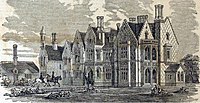Foxwarren Park
| Foxwarren Park | |
| Surrey | |
|---|---|
| Location | |
| Grid reference: | TQ07945997 |
| Location: | 51°19’43"N, 0°27’8"W |
| Village: | Wisley |
| History | |
| Built 1860 | |
| For: | Charles Buxton by Frederick Barnes |
| Country house | |
| Gothic Revival | |
| Information | |
Foxwarren Park is a Victorian country house in Wisley in Surrey, with a surrounding estate, on the Ockham and Wisley Commons.
The house was designed in 1860 by the railway architect Frederick Barnes for Charles Buxton, a brewing magnate and Member of Parliament. The house is a Grade II* listed building.[1]
From 1919 to 1955, Fox Warren was owned by Alfred Ezra who was President of the Avicultural Society — he assembled a collection of rare birds and animals on the estate — in 1939 it housed the last known pink-headed ducks in the world. It was then owned by Hannah Weinstein and chosen as a filming location for films and television series including The Adventures of Robin Hood.
Contents
History
Charles Buxton, brewer, philanthropist and politician, was also an amateur architect.[2] Having rented a range of properties around the growing village of Weybridge in the 1850s, he purchased the site for Foxwarren Park in 1855.
Buxton was heavily involved in the design of the new house, working with Frederick Barnes, known more for his designs for railway stations, particularly in Norfolk. The style is described as "harsh Victorian Gothic".[1]
The house has been suggested as the inspiration for E. H. Shepard's illustrations of Toad Hall in Kenneth Grahame's book, The Wind in the Willows.[3][4] The claim has also been made for Hardwick House[5] and Mapledurham House[6] in Oxfordshire, and Fawley Court in Buckinghamshire.[7][8][9]
The house was acquired by Alfred Ezra in 1919, who owned it until his death in 1955. He was an enthusiastic breeder of birds and created a large private collection of rare birds and animals on the estate. From in 1939 the journal Forest and Outdoors praised it as "probably the finest (private zoo) in the world"; in which state it had been since 1920 and remained so until the following year.[10][11] It hosted the last pair of known pink-headed ducks.[12]
During the Second World War, the estate hosted research facilities of engineering firm Vickers for Operation Chastise: development of Barnes Wallis's bouncing bomb.[13]
On film
In the 1950s, the house and estate was owned by Hannah Weinstein's Sapphire Films which built a castle in the deer park and used it as the location for the successful TV series, The Adventures of Robin Hood starring Richard Greene.[14] The similar show, The Adventures of Sir Lancelot, also used it as a location. Weinstein used writers who had been blacklisted in the United States as communists and this exile community included Christina Stead, who had a cottage in the grounds.[15]
In 1978, the house was used as the main location for the horror film The Comeback.[16]
Architecture
The house is built of red brick, in a polychromatic design, with terracotta dressings and blue diapering.[1]
The architectural critic Ian Nairn (d.1983) described the Model Farm attached to Foxwarren Park as "a true Struwelpeter mid-Victorian nightmare".[17] It has a separate Grade II* listing.[18]
The house's elaborate decorations and antiques may be those being compared to those of the subject house of Henry James' novel, The Spoils of Poynton:[19]...out of a Philistine, a tasteless, a hideous house; the kind of house the very walls and furniture of which constitute a kind of anguish for such a woman as I suppose the mother to be. That kind of anguish occurred to me, precisely, as a subject, during the two days I spent at Fox Warren...—'The Notebooks of Henry James', p 137[20]
References
- ↑ 1.0 1.1 1.2 National Heritage List 1189110: Foxwarren Park
- ↑ Nikolaus Pevsner: The Buildings of England: Surrey, 1962; 1971 Penguin Books ISBN 978-0-300-09675-0|p=596-598
- ↑ "Foxwarren Park, near Cobham, Surrey". http://www.victorianweb.org/art/architecture/buxton/1.html.
- ↑ Michelle Nichols (10 March 2001), "Is this house the real Toad Hall?", The Scotsman
- ↑ Davidson, Max (24 October 2015). "Secrets, scandal and Toad of Toad Hall: the properties with stories to tell". https://www.telegraph.co.uk/finance/property/11950260/Secrets-scandal-and-Toad-of-Toad-Hall-the-properties-with-stories-to-tell.html.
- ↑ BBC. "Who spawned Mr Toad?". http://www.bbc.co.uk/berkshire/content/articles/2008/10/15/wind_in_the_willows_centenary_feature.shtml.
- ↑ "High Court fight over 'Toad Hall'". BBC News. 11 July 2011. https://www.bbc.co.uk/news/uk-england-oxfordshire-14110256.
- ↑ "Would the real Toad Hall please stand up - Creation Theatre Company". 23 November 2017. https://www.creationtheatre.co.uk/real-toad-hall-please-stand/.
- ↑ "Wind in the Willows Centenary". Berks&Bucks Life. http://www.berksandbuckslife.co.uk/out-about/places/wind-in-the-willows-centenary-1-1632245.
- ↑ J. Delacourt (1956), "Alfred Ezra", Ibis 98 (1): 135–136, doi:10.1111/j.1474-919X.1956.tb03033.x
- ↑ "Mr. Ezra's hobby is his private zoo. It is probably the finest one in the world.", Forest and Outdoors 35: 117, 1939
- ↑ Robert J. Hoage, William A. Deiss, ed. (1996), New Worlds, New Animals: From Menagerie to Zoological Park in the Nineteenth Century, JHU Press, p. 148, ISBN 9780801853739
- ↑ "Dam good show from Brooklands to honour Barnes Wallis – Woking News and Mail". http://www.wokingnewsandmail.co.uk/?p=3676.
- ↑ Michael Eaton (2016), "Notes from Sherwood", Lindsay Anderson Revisited, Springer, p. 87–89, ISBN 9781137539434
- ↑ "Walton on Thames – rescued by Rover and Robin Hood", The Studio Tour, 3 February 2015, https://thebritishstudiotour.wordpress.com/2015/02/03/walton-on-thames-rescued-by-rover-and-robin-hood/
- ↑ Derek Pykett (2008), British Horror Film Locations, McFarland, p. 29, ISBN 9780786451937
- ↑ Nikolaus Pevsner: The Buildings of England: Surrey, 1962; 1971 Penguin Books ISBN 978-0-300-09675-0page 67
- ↑ Home Farm House and Barns - British Listed Buildings
- ↑ M.C. Rintoul (2014), "Foxwarren Park", Dictionary of Real People and Places in Fiction (Routledge): p. 425, ISBN 9781136119323
- ↑ The Notebooks of Henry James, page 137
